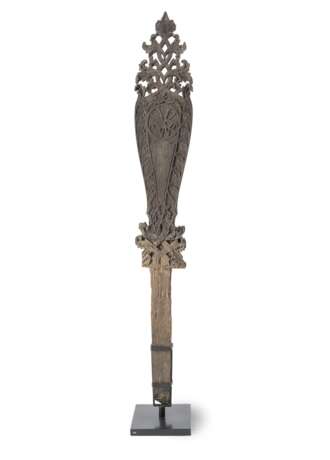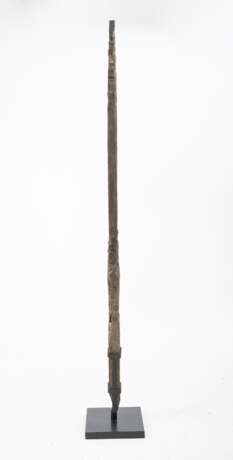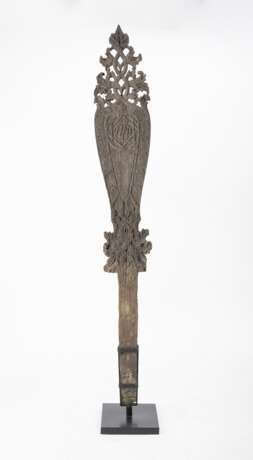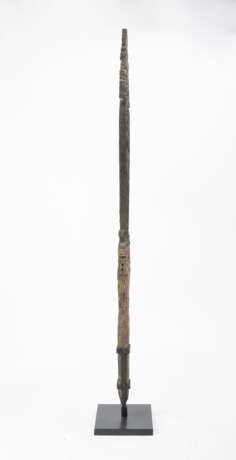ID 1218044
Lot 1527 | Grabstele ''klirieng'' der Dayak oder Dusun bzw, Kadazan aus Eisenholz
Estimate value
€ 2 000 – 3 000
H, 198 cm (o.S)/ H. 207 cm
Diese gut erhaltene Stele aus schwerem und hartem Eisenholz (belian-Holz, Eusideroxylon zwageri) ist beidseitig im flachen Relief geschnitzt. Sie besteht aus einem Stück. Als Schnitzarbeit wurden in die zentrale Hauptfläche und an deren Rand stilisierte islamische Schriftzeichen und glücksbringende Symbole in das Holz eingearbeitet. Die Spitze der Stele ist mit durchbrochenen, symmetrischen Blattranken und Orchideenmotiven (?) versehen; an der Basis finden sich ebenfalls stilisierte ornamentale Pflanzenmotive in symmetrischer Anordnung. Es dürfte sich hierbei sinngemäß um den Baum des Lebens pohon budi handeln. Das Motiv des Lebensbaumes spielt in Borneo eine wichtige Rolle in der Kosmologie, denn der Lebensbaum reicht durch alle drei Weltebenen hindurch und verbindet die Sphäre der Toten, Lebenden und Götter. Die vegetabile Auflösung der Motive hängt mit muslimischen Maßgaben zusammen. Die Stele stammt aus der Malay-Kutai-Region und stammt von einer malaiischen Untergruppe, die im muslimischen Sultanat von Kutai am Mahakam-Fluss auf Borneo lebt. Der Kulturraum wird als Dusun-Gebiet bezeichnet, ist jedoch auch von (nicht-muslimischen) Dayak besiedelt. Dusun ist eine zusammenfassende Bezeichnung für verschiedene indigene Gruppen innerhalb des malaiischen Bundesstaates Sabah auf Borneo. Die Angehörigen dieser Gruppen bezeichnen sich selbst meist nicht als Dusun, was soviel wie „Waldbauern“ bedeutet, sondern bevorzugen die jeweiligen Gruppennamen, wie Kadazan, Rungus, Ranau und Tambunan. Wegen der Gemeinsamkeiten in Kultur und Sprache mit den Kadazan wurde die gemeinsame Ethnizität der Kadazan-Dusun gebildet, die mit ca. 570.000 Angehörigen die größte ethnische Gruppe der Völker Sabahs repräsentiert. Die Stele ist im Vergleich zu anderen Exemplaren sehr groß, was in Verbindung mit der hohen Qualität auf einen hohen Rang des Verstorbenen hindeutet. Diese Stelen wurden jeweils an den Enden des Holzsarges eingesteckt und befestigt, somit war das untere, unverzierte Drittel nicht sichtbar.
Aus einer alten deutschen Privatsammlung, seit den 1950er Jahren gesammelt - Partiell minim. Altersschäden
| Auction house category: | Ethnographic tribal art |
|---|
| Auction house category: | Ethnographic tribal art |
|---|
| Address of auction |
Nagel Auktionen GmbH Neckarstrasse 189 - 191 70190 Stuttgart Germany | ||||||||||||||
|---|---|---|---|---|---|---|---|---|---|---|---|---|---|---|---|
| Preview | |||||||||||||||
| Phone | +49 (0)711 649 690 | ||||||||||||||
| Fax | +49 (0)711 649 69696 | ||||||||||||||
| Buyer Premium | 29,5% | ||||||||||||||
| Conditions of purchase | Conditions of purchase | ||||||||||||||
| Business hours | Business hours
|






